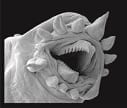This Atlas of Cool-Water Carbonates is a companion post to the Atlas of tropical carbonates, and the
For decades, all limestones were thought of as belonging to tropical realms: coral reefs, carbonate platforms, and sabkhas. Beginning in the 1970s, examples of non-tropical carbonates were published, although not always without a bit of pushing and shoving – not all adherents to the tropical paradigm were willing to give up their dominance. In New Zealand, Cam Nelson’s (Auckland and Waikato universities) studies of the Te Kuiti Group limestones, showed clearly that the usual components of tropical carbonates were different: hermatypic corals (other than the odd solitary form) and aragonite sediment-producing calcareous algae like Penicillus and Halimeda are absent, there is a predominance of shelly biotas in the carbonate framework, and marine cements generally lack aragonite. Continue reading


